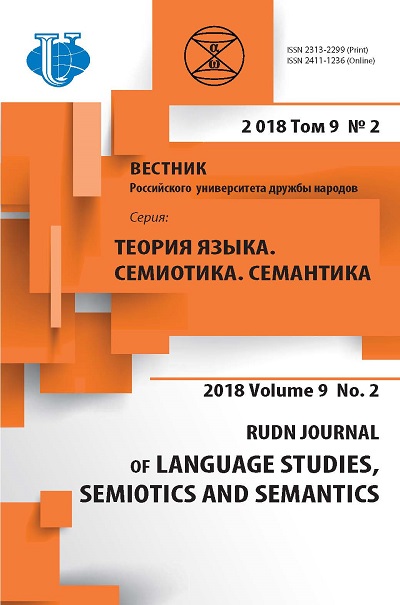ASSIMILATION OF ENGLISH LOANWORDS IN CHINESE
- Authors: Perfilieva N.V1, Hu P.2
-
Affiliations:
- RUDN University
- School of Applied Foreign Languages Shenzhen Polytechnic
- Issue: Vol 9, No 2 (2018)
- Pages: 287-301
- Section: Functional and Comparative semantics
- URL: https://journals.rudn.ru/semiotics-semantics/article/view/18744
- DOI: https://doi.org/10.22363/2313-2299-2018-9-2-287-301
- ID: 18744
Cite item
Full Text
Abstract
This article is devoted to the problem of the main ways of assimilating English words into Chinese: phonetic, semantic and calque are the main methods of assimilation of English words. Which way of loan words is preferable remains a debatable question among the Chinese linguistics. Specifics of hieroglyphic writing of the Chinese language predetermined a number of features of assimilating English neologisms by calque. Currently, a large number of words are assimilated in a mixed way, in addition to the exact translation of an English word or part of a word into Chinese, there is necessarily a hieroglyph or a combination of hieroglyphs that convey the sound of English word or part of an English word. Such sound characters can be found in both the preposition and the postposition of the semantic part of word. A distinctive feature of such hieroglyphic signs is their asemantic character. As for the graphic method, it is not a productive way in Chinese. In recent years, in Chinese language a method that hieroglyphic word synthesized by hieroglyphic signs, digital signs, symbols and English graphemes is actively used. The specific point of this loan words method in Chinese is their function as abbreviations. A separate role is the classifier in terms of assimilation of English new words in Chinese. Adding a classifier to a loan word makes it easier for Chinese speakers to understand. This article also describes the variants of assimilation English loan words in Chinese. The article provides a large number of examples illustrating typical ways of assimilating English neologisms in Chinese.
About the authors
Natalia V Perfilieva
RUDN University
Author for correspondence.
Email: nperfilieva@yandex.ru
Candidate of Philology, associate professor of General and Russian Linguistics Department at RUDN University; Scientific Interests: lexicology, loan words, neologisms
Miklukho-Maklaya st., 10, Moscow, Russia, 117198Peipei Hu
School of Applied Foreign Languages Shenzhen Polytechnic
Email: hupp1217@163.com
Candidate of Philology, Lecturer, Lecturer of the School of Applied Foreign Languages, Shenzhen Polytechnic; Scientific Interests: lexicology, loan words. neologisms
Avenue Liuxian, 2190, Nanshan District, Guangdong, China, 518055References
- Gao, Mingkai & Liu, Zhengtan (1958). The studies of loanwords in modern Chinese. Beijing: Wenzi Gaige Press. (In Chinese).
- Li, Jianguo (1996). The studies of loanwords and the codification of dictionaries. Codification of dictionaries Research, 6, 30—37. (In Chinese).
- Zhang, Dexin (1993). The 3rd wave: the assimilation and rules of loanwords. The use of the speech and writing, 3. (In Chinese).
- Liu, Shuxin (1990). The descriptions of Chinese vocabularies. Beijing: Commercial Press. (In Chinese).
- Zhang, Xiaoping (2008). The studies of developments and changes in Chinese vocabulary. Jinan: Qilu Press. (In Chinese).
- Xu, Changhe (2009). English neologisms. Shanghai: Shanghai Jiao Tong University Press. (In Chinese).
- Zou Jiayan, You Rujie (2001). The Chinese language and the Chinese society. Shanghai, Hong Kong: Fudan University Press. (In Chinese).
- Shi, Youwei (2003). Loanwords in Chinese. Beijing, Commercial Press (In Chinese).
- Shi, Youwei (2004). Loanwords — the envoys of another culture. Shanghai: Lexicographical Publishing House. (In Chinese).
- New Japanese-Chinese dictionary. (1981). Shenyang: Liaoning People’s Publishing House (In Japanese & Chinese).
- Xinhua Dictionary. (1998). Beijing: Commercial Press. (In Chinese).
- Yang, Xipeng (2007). The research of loanwords in Chinese. Shanghai: People’s Publishing House (In Chinese).
- Pan, Wenguo (1996). Comparison introduction of the Chinese and English languages. Beijing: Beijing Language and Culture University Press Publ. (In Chinese).
- The spouses of the presidents went to the Xiushuijie for shopping one by one. URL.: http://news.ifeng.com/a/20170516/51100248_0.shtml (assessed: 19.03.2018).
- Chen, Yuan (2003). Language and people. Beijing, Commercial Press. (In Chinese).
- Shen, Menying (2002). Communicative function of the letter-words. Journal of the Pingdingshan Pedagogical Institute, 6, 46—47. (In Chinese).
- Liu, Yunjuan (2002). The problems of the letter words. The use of the speech and writing, 3, 85—90. (In Chinese).
- Li, Yanjie (2006). The studies of loanwords in Chinese [abstract of dissertation]. Jinan. (In Chinese).
- Yang, Hua (2002). The studies of new words in Chinese. Haerbin. Heilongjiang Educational Press. (In Chinese)
- Wang, Dechun (2002). Multidimensional studies of the language. Beijing: Tsinghua University Press. (In Chinese).
- Pan, Wenguo, Ye, Buqing & Han, Yang. (1993). The studies of Chinese word-building: 1898—1990. Taipei: students' Book Publishing House. (In Chinese).
- Pan Wenguo (1996). Comparison introduction of the Chinese and English languages. Beijing: Beijing Language and Culture University Press. (In Chinese).
- Zhang, Qin & Jiang, Yinzhang. (1998). Word and phrases. Changchun: Northeast Normal University Press. (In Chinese).
- Hu, Yushu. (1981). The modern Chinese language. Shanghai: Shanghai Educational Publishing House. (In Chinese).
- Huang, Heqing. (1995). Chinese loanwords. Journal of Chinese word-building, 7. (In Chinese).
- Wang, Jihui & Jiao, Nina (2003). Practical abbreviations dictionary. Shanghai: Lexicographical Publishing House. (In English & Chinese).
Supplementary files












